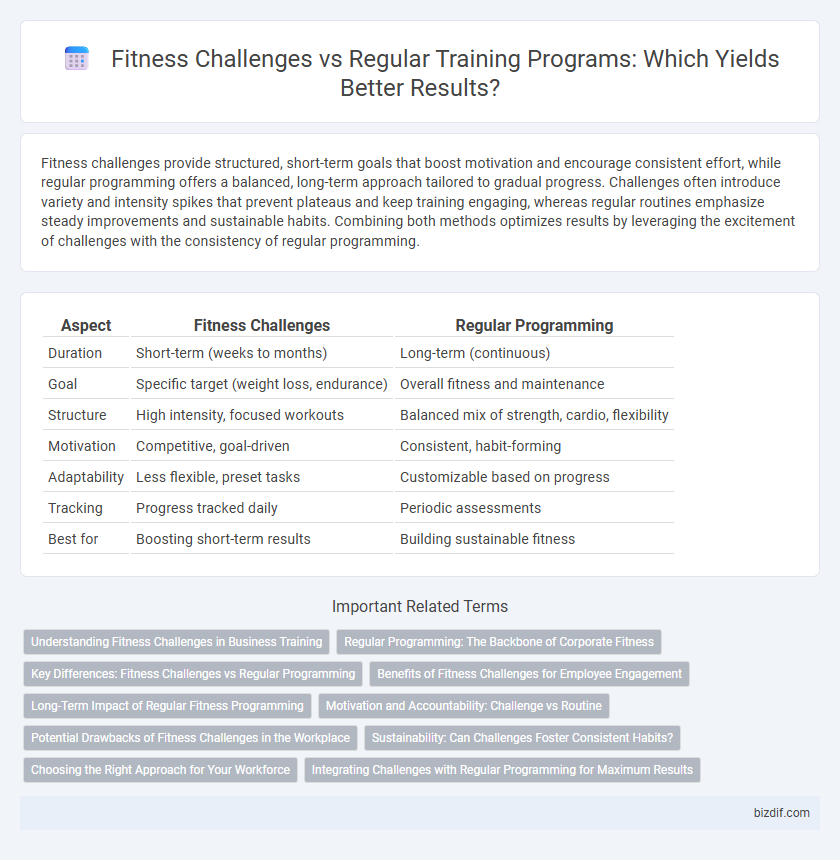Fitness challenges provide structured, short-term goals that boost motivation and encourage consistent effort, while regular programming offers a balanced, long-term approach tailored to gradual progress. Challenges often introduce variety and intensity spikes that prevent plateaus and keep training engaging, whereas regular routines emphasize steady improvements and sustainable habits. Combining both methods optimizes results by leveraging the excitement of challenges with the consistency of regular programming.
Table of Comparison
| Aspect | Fitness Challenges | Regular Programming |
|---|---|---|
| Duration | Short-term (weeks to months) | Long-term (continuous) |
| Goal | Specific target (weight loss, endurance) | Overall fitness and maintenance |
| Structure | High intensity, focused workouts | Balanced mix of strength, cardio, flexibility |
| Motivation | Competitive, goal-driven | Consistent, habit-forming |
| Adaptability | Less flexible, preset tasks | Customizable based on progress |
| Tracking | Progress tracked daily | Periodic assessments |
| Best for | Boosting short-term results | Building sustainable fitness |
Understanding Fitness Challenges in Business Training
Fitness challenges in business training create structured, goal-oriented programs that boost employee engagement and motivation by introducing competitive and time-bound activities. Unlike regular programming, which follows a steady, long-term progression, challenges emphasize short-term achievements to drive immediate improvements in physical and mental performance. Integrating fitness challenges encourages team cohesion and accountability, enhancing overall workplace wellness and productivity.
Regular Programming: The Backbone of Corporate Fitness
Regular programming serves as the backbone of corporate fitness by providing consistent, structured workouts that promote long-term health and employee well-being. Unlike short-term fitness challenges, regular programming focuses on sustained progress through tailored exercise routines and continuous support. This approach enhances physical fitness, reduces injury risk, and fosters a culture of wellness within the workplace.
Key Differences: Fitness Challenges vs Regular Programming
Fitness challenges typically offer structured, time-bound goals designed to push participants through high-intensity workouts and varied routines, fostering motivation and rapid progress. Regular programming emphasizes consistent, progressive training plans tailored to individual fitness levels, promoting long-term development and injury prevention. Key differences include the intensity bursts and community-driven accountability in challenges versus the personalized, steady progression and adaptability found in regular fitness programming.
Benefits of Fitness Challenges for Employee Engagement
Fitness challenges boost employee engagement by fostering teamwork and motivation through goal-oriented activities. These challenges introduce variety and a sense of competition that regular programming often lacks, increasing participation rates and overall enthusiasm. Enhanced social interaction and shared accomplishment during fitness challenges contribute to a healthier, more connected workplace culture.
Long-Term Impact of Regular Fitness Programming
Regular fitness programming promotes consistent progress by developing sustainable habits that enhance strength, endurance, and overall health over time. Unlike short-term fitness challenges, structured training plans reduce injury risk through gradual intensity increases and balanced recovery periods. Long-term commitment to a personalized fitness routine improves metabolic function, supports weight management, and fosters mental resilience essential for lasting wellness.
Motivation and Accountability: Challenge vs Routine
Fitness challenges boost motivation by setting clear, time-bound goals that encourage participants to push beyond their limits. Regular programming offers consistent accountability through established routines, fostering long-term discipline and habit formation. Combining structured challenges with routine workouts maximizes both motivation and sustained commitment to fitness goals.
Potential Drawbacks of Fitness Challenges in the Workplace
Fitness challenges in the workplace can lead to increased stress and unhealthy competition among employees, potentially diminishing overall morale and collaboration. These challenges often prioritize short-term results over sustainable habits, increasing the risk of injury or burnout. Lack of accommodations for varying fitness levels may exclude or discourage participation, undermining inclusivity and long-term engagement.
Sustainability: Can Challenges Foster Consistent Habits?
Fitness challenges offer intense, short-term motivation that can jumpstart new routines, but regular programming provides the gradual progression needed for sustainable habit formation. Consistency in fitness is more effectively achieved through structured, repeatable workouts that adapt to individual progress, whereas challenges often lack long-term adaptability. Research shows that combining the motivational spikes from challenges with the steady framework of regular programming yields higher adherence rates and lasting lifestyle changes.
Choosing the Right Approach for Your Workforce
Fitness challenges boost employee engagement through goal-oriented activities and foster team camaraderie, creating a dynamic and motivating environment. Regular programming emphasizes consistency with structured workouts that improve long-term health and fitness levels, supporting sustainable progress. Selecting the right approach depends on workforce preferences, balancing short-term motivation with ongoing wellness objectives to maximize overall productivity and morale.
Integrating Challenges with Regular Programming for Maximum Results
Integrating fitness challenges with regular programming enhances motivation and accelerates progress by introducing variety and goal-oriented tasks into structured workouts. Challenges target specific fitness components like endurance, strength, or flexibility, complementing the balanced approach of regular programming that ensures overall development and injury prevention. Combining both methods optimizes adaptive responses, leading to improved performance, consistency, and long-term fitness gains.
Fitness Challenges vs Regular Programming Infographic

 bizdif.com
bizdif.com